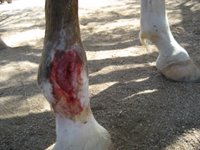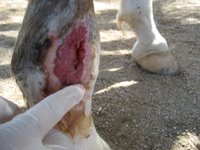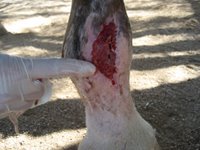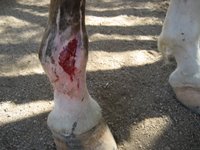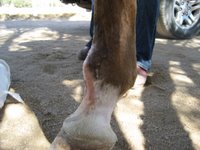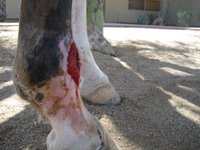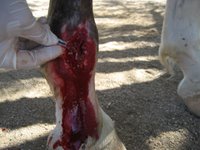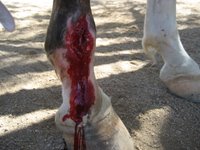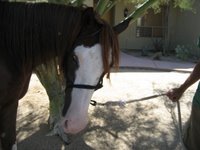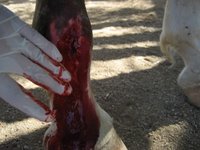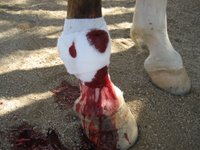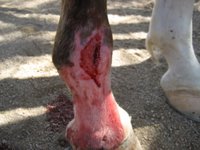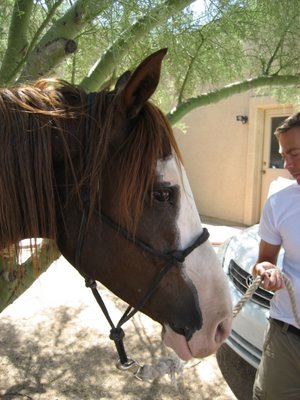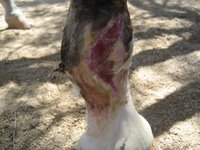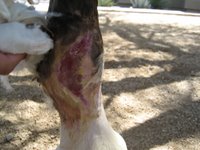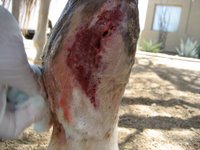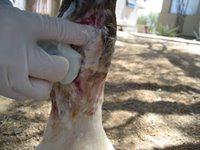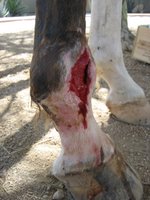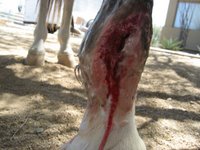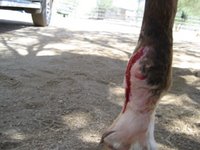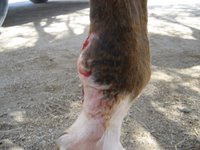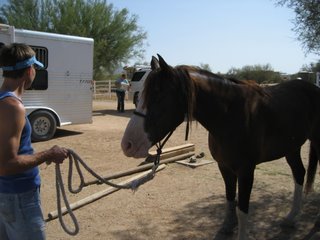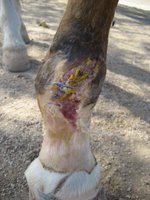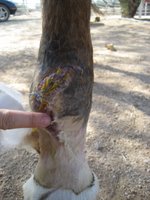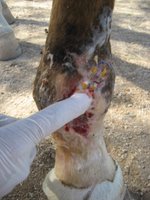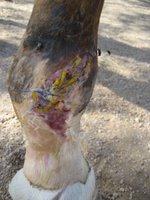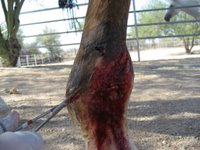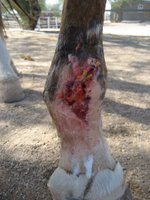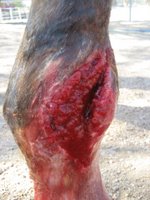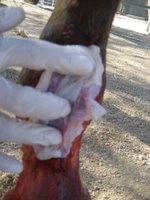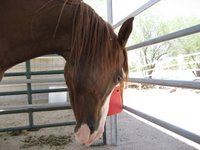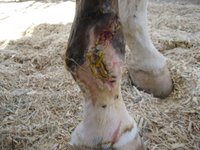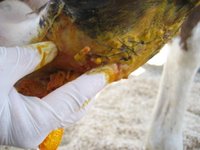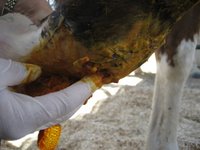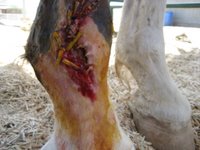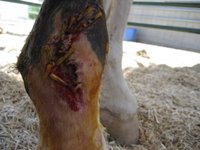I got a call from Roper on Tuesday afternoon, telling me that Far had sustained a significant injury to his front right fetlock. I called Dr. Stacey Sickler, the wonder vet, and she managed to get there in less than an hour. I was still at work, so Clydea was kind enough to come over and stand with Stacey while she prepared the wound for treatment. She had to cut away quite a bit of the skin because of the nature of the cut. It seems that he was digging under some roots of an old Palo Verde tree, and ripped his fetlock open on some exposed roots. Three dead trees have subsequently been removed from the paddock.
It was a quite a jagged cut and the wound was rough and full of blood. When I got home, the wound was cleaned up nicely; I was shocked at how deep the wound was. He ripped away most of the flesh around the joint, and partially severed his extensor tendon. Further analysis revealed that the tendon is still working, and a flushing of the joint revealed that the joint was not compromised. He got more than 80 sutures over three layers: Stacey worked on him for more than two hours. He is on a long-term sedative to keep him from moving around in his stall too much. The effects will apparently be felt for the next four weeks. He seems to be quite resigned to jail – he is eating and drinking well and shows signs on his hocks over the last couple of days of laying down (although I’m not sure how he gets back up!).
He is in a complex tight bandaging system with a splint made from PVC pipe across the entire lower leg to keep his joint from flexing as much as possible. He was put on Genomiacin and Pen-Aqueous shots, which had to be administered twice daily for the first five days. The first five days were the most critical to make it through and avoid infection, which he seems to have achieved: infection was our biggest risk, and the challenge is also going to be helping the wound heal since it is on such an active joint. He will likely be laid off for three months, if all goes well.
The suturing process was amazing – because of the location of the injury, Stacey had to use plastic stints on the outside of each entry of the suture through the skin, otherwise they will rip through the skin and achieve nothing. She used an IV tube, cut up into macaroni lengths.
When she pulled the bandages today, none of the sutures had pulled through the skin. Stacey was really pleased with the progress, and although the smell was nasty, the wound itself looked clean and healthy. There was very little swelling and very little discharge. She applied an amnionic tissue patch to the wound (pretty cool!), which will dramatically speed up the healing process – helping the flesh connect over the wound much more quickly than without.
The penicillin shots are now finished, and he is coming off the twice-daily Bute. We’re glad the shots are over – his neck was starting to get lumpy! The current bandages will come off in five days, replaced with another set for another five days. Stacey hopes to get ten more days on these sutures, and the splint should come off in ten days.
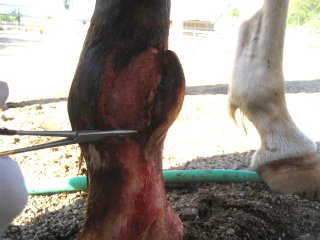
Day One: The photo is a little dark, but you can see here that the extensor tendon is being stitched back together. Click on any of the photos to see an enlarged image.
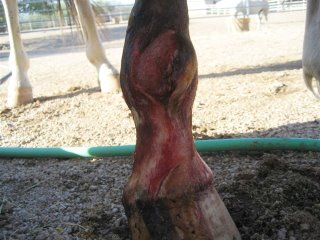
The muscle and tendon are now stitched together.
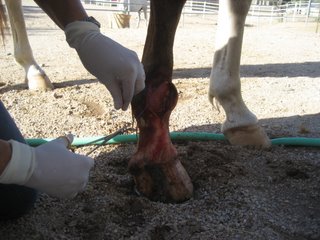
This photo shows the tendon stitched back together. The muscle has been stitched back together and now begins the challenging task of stitching the skin.
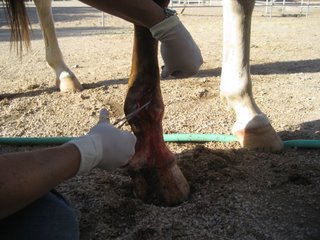
The stints are visible in this shot - they will help keep the thread from ripping through the skin.
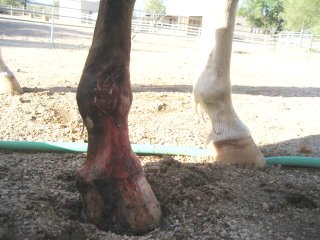
Most of the stints are in, Dr. Sickler will pull the skin a little tighter after this, but the two sides will not meet because the skin has been trimmed and because the skin had already started to thicken. I likened it to a pig's ear at the time.
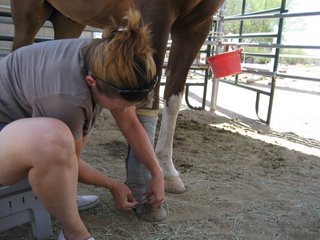
Day Five: Stacey (who is eight months pregnant) came back on Sunday afternoon to remove the splint and bandages, then cleaned, dressed and re-wrapped the wound.
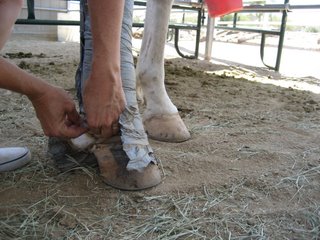
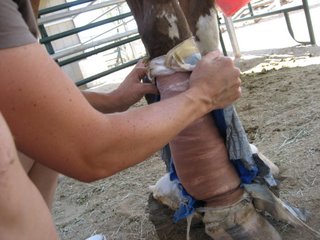
Removal of the duct tape, splint, vet wrap.
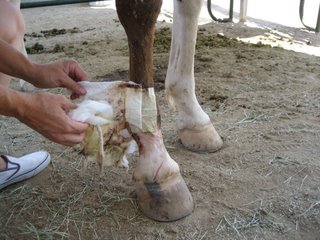
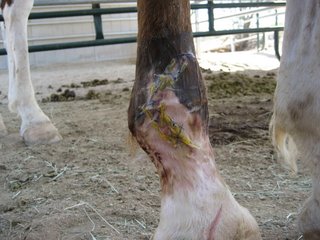
The wound is revealed - still looking clean; smelling quite nasty; very little swelling, and not one suture was popped!
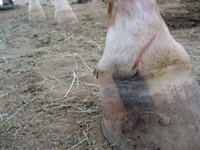
There is a smaller contusion just above the coronet band, and the hoof has been slightly cut. There should be no resulting issues from this.
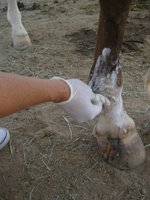
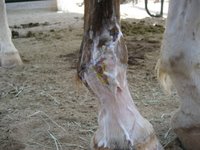
Cleaning the wound.
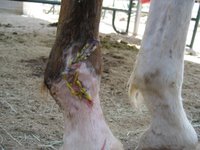
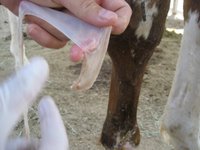
The cleaned wound (left); preparing the amnionic tissue patch for application (right)
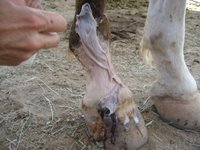
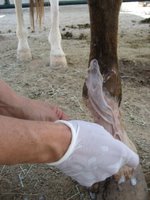
Applying the amnionic tissue patch. There is some granulation tissue under the skin on the front of the fetlock, which makes the joint appear slightly larger. We will manage that later with DMSO gel. The joint is in good health and he is moving around with no sign of lameness.
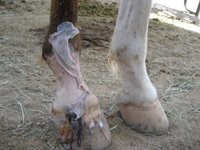
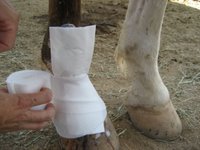
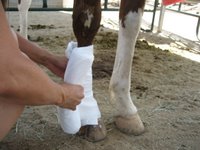
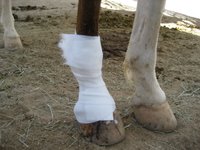
Wrapping with Gamgee (by 3M). The wound was first covered with Tefla non-adherant pads to stop the bandage from sticking to it.
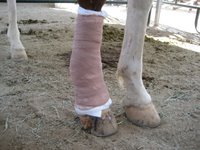
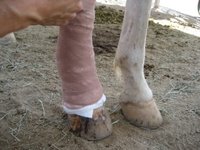
The third layer of bandage: a simple gauze type.
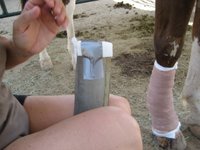
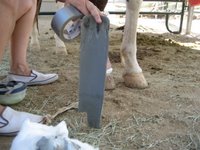
Preparing the coveted PVC pipe splint with cotton at each end for greater comfort.
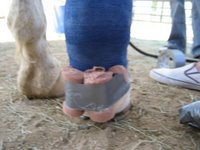
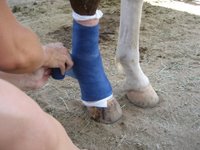
Adding the fourth layer: vet wrap and some gauze bandage to keep the splint tight across the heel bulb to keep movement in the area to a minimum.
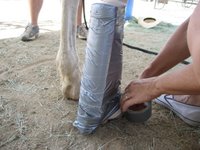
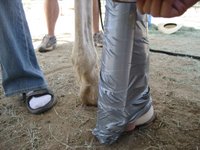
Elastikon (by 3M) is wrapped top and bottom - because it sticks so well. Then the splint is attached using Duct tape.
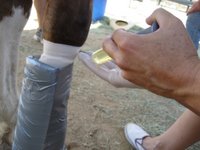
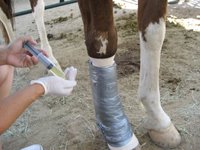
The finishing touch is application of liquid bute to the whole thing - it is the most repulsive thing Stacey can find to keep Far from eating the nasty thing off his leg. His feet are at six weeks - but he will have to wait another two weeks before getting reset.
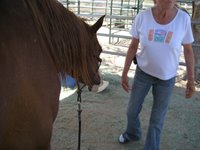

Far was sedated for the cleaning of the wound; Dr. Sickler brought her two-year old, Jack, who was very interested by the whole thing!
